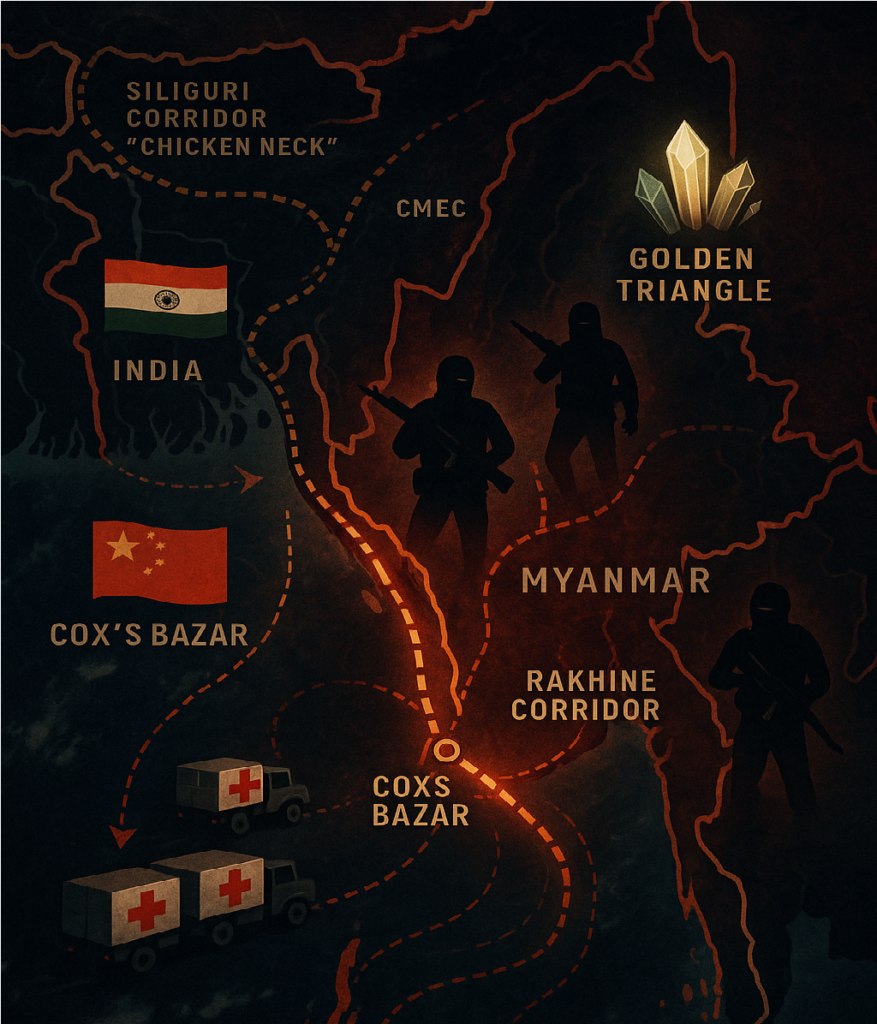
We’ve talked before about how Bangladesh has often played the role of a proxy for Pakistan — a launchpad for pressure on India’s vulnerable Siliguri Corridor, or the ‘chicken neck’ that connects the Northeast to the rest of the country. But there’s a new twist brewing in the region. The Cox’s Bazar–Rakhine Corridor, backed by the UN and framed as a humanitarian effort to support Myanmar’s Rakhine State, might be something much bigger. Behind the scenes, it looks like the US is eyeing a strategic foothold — a way to counter China’s grip on the Golden Triangle and tap into Myanmar’s rich, rare earth reserves.
The Story
What began as an internal military coup in Myanmar in February 2021 has steadily evolved into a complex geopolitical faultline, implicating major powers and altering the strategic landscape of South and Southeast Asia. At the centre of this unfolding drama lies the Bangladesh–Myanmar frontier – a volatile region that is rapidly emerging as a critical chessboard for great-power manoeuvring, infrastructure rivalries, and civil-military tensions.
The Fallout of the Myanmar Coup
The February 2021 military coup in Myanmar dismantled the fragile democratic framework that had been evolving in the country. The junta’s seizure of power triggered widespread protests and intensified long-standing ethnic conflicts, most notably the unresolved Rohingya crisis.
Facing global condemnation and sanctions, the Myanmar military regime turned towards its traditional allies, China and Russia, for diplomatic support and military assistance. Reports indicate that from 2021 to 2023, both nations supplied over USD 400 million in arms, including MiG-29 fighter jets, helicopters, and artillery[1]. Amid this chaos, the Arakan Army, a powerful insurgent group advocating for greater autonomy in Rakhine State, capitalised on the political vacuum.
Operation 1027: The Arakan Army’s Ascendancy
In November 2023, the Arakan Army launched a sweeping military offensive dubbed “Operation 1027.” By mid-2025, it had gained control over 14 of Rakhine’s 17 townships, including key towns such as Maungdaw, Buthidaung, and Paletwa along the Naf River. These territorial gains effectively placed the entire Bangladesh–Myanmar frontier under Arakan Army control.
This unprecedented shift in power dynamics compelled both Dhaka and New Delhi to recalibrate their foreign policy approaches. Bangladesh initiated informal border management discussions with the Arakan while reports emerged of Arakan representatives quietly establishing a presence in Mizoram. India, deeply invested in its northeastern connectivity initiatives, notably the Kaladan Multi-Modal Transit Project, began backchannel engagements with the Arakan Army through intermediaries. China’s Myanmar policy follows a deliberate dual-track approach—balancing ties with both the military junta and ethnic armed organisations EAOs). This strategic hedging allows Beijing to safeguard its interests regardless of who holds power. Such calibrated engagement underscores China’s pragmatism in a volatile geopolitical theatre [2]
By establishing humanitarian operations and logistical infrastructure in Rakhine, Washington aims to curb China's unfettered access to these resources, reinforce its presence in mainland Southeast Asia, and extend its Indo-Pacific strategy into a new front.
Western Initiatives: The Rakhine Humanitarian Corridor
Against this backdrop, the United States and the United Nations began advocating for a humanitarian corridor from Cox’s Bazar to Rakhine State. Framed as a humanitarian response to the deteriorating conditions in western Myanmar, the proposal also carried strategic undertones, potentially countering Chinese and Russian influence in the region.
For the United States, the humanitarian corridor is more than a relief operation [3]; it is a strategic wedge to gain operational presence near the Golden Triangle—a resource-rich and geopolitically vital zone where the borders of Myanmar, Laos, and Thailand converge. This region is known not only for illicit trade routes but also for vast reserves of rare earth elements critical to global tech supply chains. By establishing humanitarian operations and logistical infrastructure in Rakhine, Washington aims to curb China’s unfettered access to these resources, reinforce its presence in mainland Southeast Asia, and extend its Indo-Pacific strategy into a new front.
By September 2024, the International Committee of the Red Cross (ICRC) had formally begun exploring potential humanitarian aid routes through Bangladesh or Thailand. This proposal triggered considerable debate within Bangladesh, as concerns grew over the possibility of the country being drawn into great-power rivalry. The Bangladeshi military has repeatedly cautioned that permitting such a corridor could entangle the nation in broader proxy conflicts, particularly given the lack of clarity surrounding the long-term objectives of the initiative.
A key concern centres around the Arakan Rohingya Salvation Army (ARSA), an armed insurgent group claiming to represent the interests of the Rohingya Muslim minority in Myanmar’s Rakhine State. ARSA has been involved in sporadic attacks against Myanmar’s security forces since 2017, actions that the military regime in Naypyidaw has used to justify brutal crackdowns and mass displacement of the Rohingya population. Some regional analysts allege that the United States is covertly funding ARSA, now reportedly equipped with small arms and guerrilla capabilities, as a counterweight to the Arakan Army seeking autonomy from the Myanmar central government. These dynamics have raised alarms in Dhaka over the risk of being drawn into a theatre of escalating proxy conflict between major powers.
India, deeply invested in its northeastern connectivity initiatives, notably the Kaladan Multi-Modal Transit Project, began backchannel engagements with the Arakan Army through intermediaries.
Civil-Military Divergence in Bangladesh
Bangladesh’s domestic political landscape underwent a major transformation in the wake of student-led protests in 2023. These demonstrations, opposing Prime Minister Sheikh Hasina’s controversial quota system in civil services, laid the foundation for a shift in political power. The Yunus-led government subsequently came to power and, despite being labelled an American stooge, adopted a markedly pro-China orientation.
However, this foreign policy pivot exposed deep rifts within Bangladesh’s governance. In early 2025, Army Chief General Waker-Uz-Zaman publicly demanded national elections by the end of the year to restore democratic legitimacy and return the military to its constitutional role. He also issued stern warnings regarding strategic sovereignty, opposing the UN-proposed humanitarian corridor and expressing concern over foreign management of Chittagong Port and the use of Starlink internet services.[4]
Tensions escalated in May 2025 when Bangladesh’s National Security Adviser confirmed official support for the UN-led corridor. This prompted the military to issue statements declaring it would not participate in any initiative that jeopardised national security. The situation reached a crescendo when Bangladesh recalled its ambassador from Naypyidaw over cooperation issues, and Prime Minister Yunus reportedly considered resignation under internal pressure. Though Western observers found no credible evidence of foreign interference, the atmosphere remained fraught with suspicion.
The situation reached a crescendo when Bangladesh recalled its ambassador from Naypyidaw over cooperation issues, and Prime Minister Yunus reportedly considered resignation under internal pressure.
India’s Strategic Stakes: Kaladan in Jeopardy
India’s Kaladan Multi-Modal Transit Project, conceived under the “Act East” policy, was designed to connect the eastern port of Sittwe in Myanmar to Mizoram in India, bypassing Bangladesh. Traditionally, India accesses its northeastern states through the narrow Siliguri Corridor — a strategic bottleneck often called the “Chicken’s Neck.” By developing an alternative route via Myanmar, India aims to ease pressure on the Siliguri stretch and reduce overdependence on transit through Bangladeshi territory.
While the Sittwe Port (Phase I) remains under Indian operational control, the inland road network now traverses areas dominated by the Arakan Army, putting the project at considerable risk. [5]
Analysts caution that unless India begins formal engagement with the Arakan Army and other local ethnic factions, the Kaladan initiative could face indefinite delays. Meanwhile, China’s parallel China–Myanmar Economic Corridor (CMEC) continues to progress with fewer interruptions, owing to its close ties with the junta. With tensions simmering in Mizoram and rumours circulating about Bangladeshi ambitions to establish a parallel base in Lalmonirhat[6]—potentially projecting influence into Tripura—India now finds its strategic backyard turning into a diplomatic minefield. The spectre of a ‘land corridor grab’, including hoax threats over annexing the sensitive Siliguri corridor, has further stoked anxieties in New Delhi.
With India, China, the United States, and Russia all positioning themselves in this increasingly complex theatre, the Bangladesh–Myanmar frontier has become a critical fulcrum for Asia’s emerging great game.
Proxy Rivalries and Strategic Infrastructure
Today, the Bangladesh–Myanmar border region represents more than a humanitarian crisis; it is the epicentre of a multi-layered contest involving state and non-state actors. Strategic infrastructure projects such as India’s Kaladan and China’s CMEC, humanitarian corridors championed by the West, and arms flows from Beijing and Moscow to Naypyidaw all intertwine in this geopolitical landscape.
As one Bangladeshi observer aptly stated, “The opening of the Chittagong–Rakhine corridor could mark the beginning of a new phase in Bangladesh’s geopolitical history.” With India, China, the United States, and Russia all positioning themselves in this increasingly complex theatre, the Bangladesh–Myanmar frontier has become a critical fulcrum for Asia’s emerging great game.
In conclusion, the formerly disregarded borders of South Asia are quickly emerging as the pivot of Indo-Pacific strategy. What was formerly written off as peripheral territory has become contested territory, with humanitarian channels concealing deeper geopolitical undercurrents and infrastructure corridors serving as influence corridors. The region is getting closer to being a major strategic intersection as New Delhi is under pressure to defend its northeastern gateway, and Dhaka is juggling shifting external allegiances with domestic discontent. The game is now about placement rather than presence because of Beijing’s constant encroachment, Washington’s newly discovered assertiveness, and Yunus’s emergence as a wildcard player in this changing storyline. The board is set, but the rules are in flux.
References:
- [1] https://www.reuters.com/world/un-expert-says-russia-china-sending-deadly-aid-myanmars-military-2023-05-17/
- [2] https://www.9dashline.com/article/china-is-hedging-in-myanmar-by-leveraging-its-influence#:~:text=While%20it%20may%20appear%20that,the%20risks%20of%20any%20fallout
- [3] https://www.lowyinstitute.org/the-interpreter/united-states-really-planning-proxy-war-myanmar
- [4] https://www.indiatoday.in/world/story/bangladesh-blood-rakhine-corridor-myanmar-yunus-interim-government-backtracks-army-chief-waker-uz-zaman-warning-2728760-2025-05-22
- [5] https://swarajyamag.com/world/india-must-swiftly-seize-the-strategic-window-in-western-myanmar-as-chin-arakan-rebels-push-back-junta
- [6] https://www.business-standard.com/external-affairs-defence-security/news/india-revives-kailashahar-airbase-china-lalmonirhat-upgrade-125052701761_1.html
Sughosh Joshi is a CA Finalist and B.Com graduate with a strong interest in economics, geopolitics, and the analysis of international affairs, particularly those impacting India. Views expressed are the author’s own.
